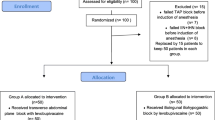Abstract
Although anesthesia and post-operative analgesia are associated with specific morbidity, regional anesthesia is not systematically given during groin hernia surgery. The goals of this work were to determine the anatomical bases of safe ilio-inguinal (II)-hypogastric anesthesia that can be prolonged into the post-operative period and to validate this technique on anatomical preparations and in clinical situations. We studied the courses of the ilio-hypogastric (IH) and II nerves in 33 halves of 20 embalmed adult cadavers. The intermediate portion of the IH and II nerves, located between the transverse and the internal oblique muscles, were found to be suitable for a simultaneous block with a single injection. We assessed the feasibility of injecting a percutaneous infiltration into this space by injecting a dye before dissection. In 75% of cases, we observed percutaneous coloring of the nerves, confirming that this site was suitable. To guide the infiltration, the points where the nerves passed through the transverse and the internal oblique muscles were located from the iliac crest and anterior and superior iliac spine, respectively. The nerve trunks were grouped for over 5 cm in a cell-fat layer running between these two deep muscles. It was possible to position a micro-catheter in this anatomical space to allow repeated injections. The results of this anatomical study were used to modify the technique so that it could be used to provide regional anesthesia in five patients operated on for hernia. Post-operative pain was very effectively controlled in four cases with no complications.








Similar content being viewed by others
References
Akita K, Niga S, Yamato Y, Muneta T, Sato T (1999) Anatomic basis of chronic groin pain with special reference to sports hernia. Surg Radiol Anat 21:1–5
Al-dabbagh AK (2002) Anatomical variations of the inguinal nerves and risks of injury in 110 hernia repairs. Surg Radiol Anat 24:102–107
Amid PK, Shulman AG, Lichtenstein IL (1994) Local anesthesia for inguinal hernia repair step-by-step procedure. Ann Surg 220:735–737
Bugedo GJ, Carcamo CR, Mertens RA, Dagnino JA, Munoz HR (1990) Preoperative percutaneous ilioinguinal and iliohypogastric nerve block with 0.5% bupivacaine for post-herniorrhaphy pain management in adults. Reg Anesth 15:130–133
Buist RJ, Mansour NY (1988) Femoral nerve block as a complication of ilio-inguinal nerve block. Anesthesia 43:805
Carre P, Mollet J, Le Poultel S, Costey G, Ecoffey C (2001) Ilio-inguinal Ilio-hypogastric nerve block with a single puncture: an alternative for anesthesia in emergency inguinal surgery. Ann Fr Anesth Reanim 20: 643–646
Chevallier JM, Wind P, Lassau JP (1996) Damage to the inguino-femoral nerves in the treatment of hernias. An anatomical hazard of traditional and laparoscopic techniques. Ann Chir 50:767–775
Dalens B (1990) The value of peripheral blocks in pediatric anesthesia. Cah Anesthesiol 38:547–559
Dalens B, Ecoffey C, Joly A, Giaufre E, Gustafsson U, Huledal G, Larsson LE (2001) Pharmacokinetics and analgesic effect of ropivacaine following ilioinguinal iliohypogastric nerve block in children. Pediatr Anaesth 11:415–420
Dierking GW, Dahl JB, Kanstrup J, Dahl A, Kehlet H (1992) Effect of pre- vs postoperative inguinal field block on postoperative pain after herniorrhaphy. Br J Anaesth 68:344–348
Dierking GW, Ostergaard E, Ostergard HT, Dahl JB (1994) The effects of wound infiltration with bupivacaine versus saline on postoperative pain and opioid requirements after herniorrhaphy. Acta Anaesthesiol Scand 38:289–292
Ding Y, White PF (1995) Post-herniorrhaphy pain in outpatients after pre-incision ilioinguinal-hypogastric nerve block during monitored anesthesia care. Can J Anaesth 42: 12–15
Ejlersen E, Andersen HB, Eliasen KR, Mogensen TS (1993) Preoperative or postoperative local anesthesia. Effect on postoperative pain treatment. Ugeskr Laeger 155: 4079–4082
Ghani KR, McMillan R, Paterson-Brown S (2002) Transient femoral nerve palsy following ilio-inguinal nerve blockade for day case inguinal hernia repair. J R Coll Surg Edinb 47:626–629
Langlade A (1998) Patient-controlled analgesia. Benefits, risks, methods of monitoring. Ann Fr Anesth Reanim 17:585–598
Mandelkow H, Loeweneck H (1988) The iliohypogastric and ilioinguinal nerves. Distribution in the abdominal wall, danger areas in surgical incisions in the inguinal and pubic regions and reflected visceral pain in their dermatomes. Surg Radiol Anat 10:145–149
Moosman DA, Oelrich TM (1977) Prevention of accidental trauma to the iloinguinal nerve during inguinal hernoirrhaphy. Am J Surg 133:146–148
Petros JG, Rimm EB, Robillard RJ, Argy O (1991) Factors influencing postoperative urinary retention in patients undergoing elective inguinal herniorrhaphy (discussion 434). Am J Surg 161: 431–433
Rab M, Ebmer And J, Dellon AL (2001). Anatomic variability of the ilioinguinal and genitofemoral nerve: implications for the treatment of groin pain. Plast Reconstr Surg 108:1618–1623
Salama J, Sarfati E, Chevrel J (1983) The anatomical bases of nerve lesions arisisng during the reduction of inguinal hernia. Anat Clin 5:71–81
Starling JR, Harms BA (1989) Diagnosis and treatment of genitofemoral and ilioinguinal neuralgia. World J Surg 13:586–591
Starling JR, Harms BA, Schroeder ME, Eichman PL (1987) Diagnosis and treatment of genitofemoral and ilioinguinal entrapment neuralgia. Surgery 102:581–586
Stulz P, Pfeiffer KM (1982) Peripheral nerve injuries resulting from common surgical procedures in the lower portion of the abdomen. Arch Surg 117:324–327
Acknowledgments
We would acknowledge the Research Association: Association Recherche Oncologie Digestive (A.R.O.L.D Boulogne) for their grant support.
Author information
Authors and Affiliations
Corresponding author
Additional information
This study was supported by grants from the AROLD association (Boulogne France).
Rights and permissions
About this article
Cite this article
Peschaud, F., Malafosse, R., Floch-Prigent, P.L. et al. Anatomical bases of prolonged ilio-inguinal-hypogastric regional anesthesia. Surg Radiol Anat 28, 511–517 (2006). https://doi.org/10.1007/s00276-006-0132-x
Received:
Accepted:
Published:
Issue Date:
DOI: https://doi.org/10.1007/s00276-006-0132-x




